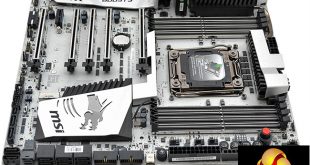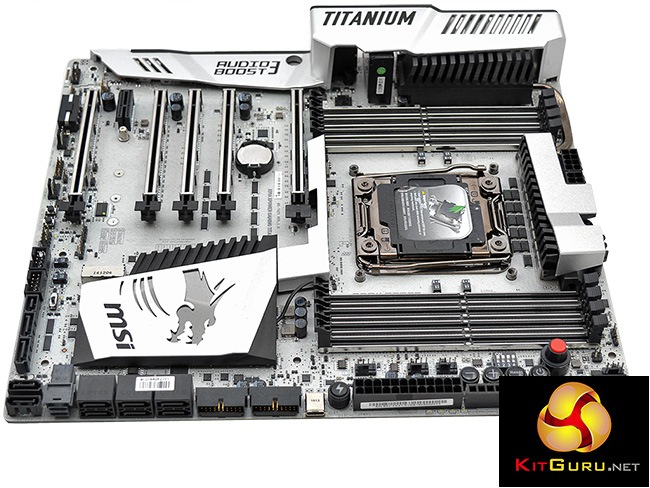
Spoilt for choice would be an understatement for any prospective buyers of the X99 platform. MSI alone has a motherboard for almost every possible price point, use-case scenario and type of user. Add other motherboard vendors into the mix and the amount of choice is dizzying.
With its high-end price point and feature-set the MSI X99A XPower Gaming Titanium locks horns with the likes of the ASUS X99-DELUXE II and Gigabyte X99-Designare EX RGB, though ASRock lacks a similarly priced offering. A dissection of the product name reveals a motherboard that is trying to cater to Gamers and Overclockers on the X99 platform.

“XPower” denotes the overclocking-focus of the motherboard's feature-set with its high quality CPU VRM and power topology, as well as voltage read-out points, onboard power, reset, clear CMOS and BCLK adjust buttons, a dual BIOS with a selector switch, slow mode booting jumper and switch and a debug code reader, among other things.
While the board is XPower by name MSI has since phased out the use of a yellow and black colour scheme, seen on previous generation XPower motherboards. MSI has instead integrated almost everything under the “Gaming” banner, at least for the high end, since this strategy has been successful for the company. MSI is emphasising the audio, connectivity, networking and performance elements of this motherboard from a gaming perspective.
The last component of the long name, “Titanium”, refers primarily to the motherboard's aesthetics. In an increasingly competitive motherboard market MSI has sought an interesting way to differentiate itself and silver heat sinks, a silver rear I/O shroud and a silver PCB certainly does that. No other motherboard vendor has a motherboard quite as uniquely styled as MSI's X99A XPower Gaming Titanium.
| MSI X99A XPower Gaming Titanium | |
| Form Factor |
ATX, 30.5 x 27.2 cm |
| CPU Socket |
LGA 2011-V3, 12 Phase VRM |
| Chipset | Intel X99 |
| Memory | DDR4, 8 DIMMs, up to 3466+MHz (OC) and 128GB |
| Onboard Graphics |
None |
| Discrete Graphics | Up to 4-way Nvidia SLI or AMD CrossFireX, Quad-SLI and Quad-CrossFireX |
| Expansion Slots | 5 x PCIe 3.0 X16 (Supports X16 or X16/X16 or X16/X16/X8 or X16/X8/X8/X8 with 40-Lane CPU, X16 or X16/X8 or X8/X8/X8 or X8/X8/X8/X4 with 28-Lane CPU) 1 x PCIe 2.0 X1 |
| Storage | 10 SATA III 1 x SATA Express (shared with two SATA ports) 1 x M.2 (PCIe or SATA) 1 x U.2* *Unavailable when PCI_E6 slot is occupied |
| USB | 11 x USB 3.0 Ports (2 via ASM1142 Front, 4 from VIA VL805 Rear, 5 via Intel X99, 2 Rear and 3 Front (one type-C) 2 x USB 3.1 Ports (2 Rear, Type A and C, via ASM1142) 7 x USB 2.0 Ports (3 Rear, 4 Front, via X99) |
| Networking | 1 x Intel I218-V 1 x Intel AC8260 dual-band 802.11ac with Bluetooth up to 4.2 |
| Audio | Realtek ALC1150 7.1 channel output with dual-headphone amplifiers, chemi-con audio capacitors, gold-plated audio jacks and PCB isolation |
| Fan Headers | 7 x 4-pin (3 x SYS, 1 x CPU, 2 x CPU_OPT, 1 x W_PUMP) |
| Rear I/O | 1 x PS/2 keyboard/ mouse combo port 2 x USB 2.0 ports 1 x BIOS FLASHBACK+/ USB 2.0 port 1 x Clear CMOS button 1 x USB 3.1 Gen2 port 1 x USB 3.1 Gen2 Type-C port 6 x USB 3.1 Gen1 ports 1 x LAN (RJ45) port 1 x Optical S/PDIF OUT connector 5 x OFC audio jacks |
| UEFI | UEFI AMI Dual BIOS with selector switch |
 KitGuru KitGuru.net – Tech News | Hardware News | Hardware Reviews | IOS | Mobile | Gaming | Graphics Cards
KitGuru KitGuru.net – Tech News | Hardware News | Hardware Reviews | IOS | Mobile | Gaming | Graphics Cards



Why that 6800K stuck at 4.2 ???
Using MSI’s command center and turning off hyperthreading, I’m able to hit a stable & usable 4.6ghz on the X99A Titanium with a 5930k & 32Gb of Corsair RAM @ 2400Mhz. Extended gaming or video encoding with a Corsair H110i GT, the cpu never gets warmer than 58C. This is some very nice gear. I’m quite satisfied with how it all works together, and it looks stunning inside the Enthoo Luxe chassis.
My X99A gaming pro carbon was able to clock the 6800k to 4.2 GHz at 1.251 volts, and 4.1 GHz at 1.194 volts, but 4.3 GHz at 1.3 volts, Windows would crash after booting up. I haven’t tried 1.315 or 1.32 volts yet.
What voltage are you using for the CPU @4.6ghz?